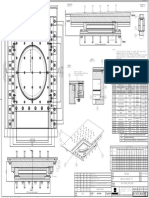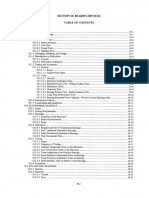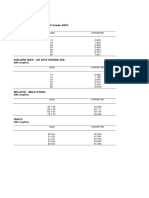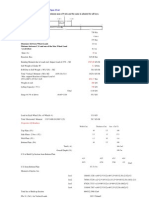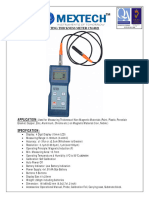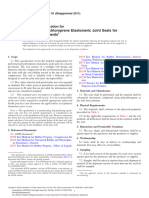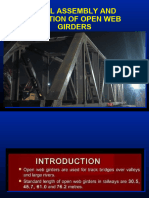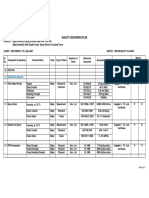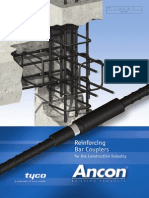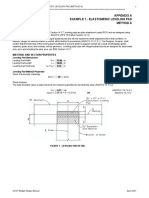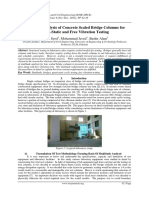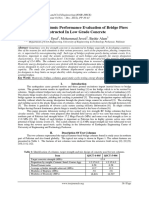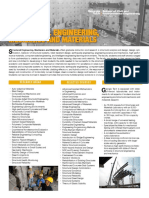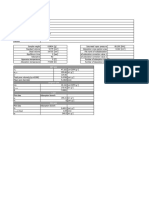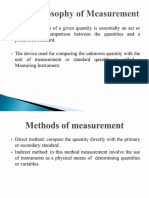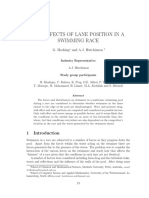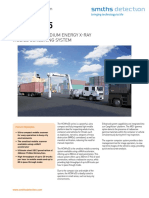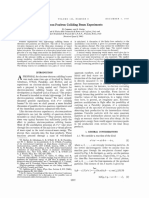EXAMPLE 1 - ELASTOMERIC LEVELING PAD (METHOD A) 1
==================================================================================================
APPENDIX A
EXAMPLE 1 - ELASTOMERIC LEVELING PAD
METHOD A
GENERAL INFORMATION
Per CDOT Bridge Design Manual (BDM) Section 14.5.7, leveling pads are plain elastomeric pads (PEP) and are designed using
Method A procedures in accordance with AASHTO LRFD 7th Edition Section 14.7.6
Leveling pads are primarily used with integral substructures and will not experience shear displacements in that condition. In
addition, design for bearing rotation is implicit within Method A procedures (AASHTO C14.7.6.1). The Designer, however, shall
confirm that the thickness of the leveling pad is sufficient to prevent girder-to-support contact as a result of anticipated girder
rotations, girder skew, and roadway vertical geometry. Leveling pads used with integral substructures are designed for dead
loads only, up to and including the deck pour, per BDM Section 14.5.7.
MATERIAL AND SECTION PROPERTIES
Leveling Pad Dimensions
Leveling Pad Width W= 37.00 in AASHTO 14.7.5.1
Leveling Pad Length L= 10.00 in AASHTO 14.7.5.1
Leveling Pad Thickness hri = hrt = 0.75 in Typically between 1/2" and 1"
Leveling Pad Material Properties
Shore A Durometer Hardness
Duro = 60 (min) BDM 14.5.7
Shear Modulus
The least favorable value is assumed since the material is specified by its hardness value (AASHTO 14.7.6.2)
G= 0.13 ksi AASHTO T14.7.6.2-1
Check = 0.08 ksi < G < 0.25 ksi OK AASHTO 14.7.6.2
FIGURE 1 - LEVELING PAD DETAIL
==================================================================================================
CDOT Bridge Design Manual April 2021
�EXAMPLE 1 - ELASTOMERIC LEVELING PAD (METHOD A) 2
==================================================================================================
BRIDGE GEOMETRY
Profile grade between supports %= -1.50 %
∁L bearing to FF Abutment Ad = 1.25 ft
BEARING ROTATIONS
Rotations include effects of girder camber. For all rotation values, positive indicates an upward rotation while negative indicates
a downward rotation.
Service I Limit State Loads
Net girder rotations (camber plus 𝜃 = 0.004 rad
dead loads)
Include a rotational allowance of 0.005 radians due to uncertainties in bearing fabrication and bearing seats. Per
BDM 14.5.4, the flatness tolerance for bearing seat uncertainties is accounted for in the rotational allowance.
Construction Tolerance 𝜃 = 0.005 rad AASHTO 14.4.2.1
BEARING LOADS
Loads acting on the leveling pad are dead load girder reactions, up to and including the deck pour, at the service limit state.
Loads are per bearing.
Service I Limit State
DL = 136.00 kip
SOLUTION
Shape Factor
Total thickness of interior layer, h ri, is equal to total elastomer thickness, h rt (hri = hrt)
Rectangular, plain bearing shape factor without holes:
𝐿𝑊
𝑆𝑖 = = (10.00*37.00) / [2*0.75*(10.00+37.00)] = 5.25 AASHTO 14.7.5.1-1
2ℎ (𝐿 + 𝑊)
Compressive Stress AASHTO 14.7.6.3.2
The compressive stress of the leveling pad shall satisfy the criteria below for a PEP.
𝜎 = average compressive stress due to total load from applicable service load combinations
𝜎 ≤ 1.00𝐺𝑆 = 1.00*0.13*5.25 = 0.68 ksi AASHTO 14.7.6.3.2-1
and
𝜎 ≤ 0.80 𝑘𝑠𝑖 AASHTO 14.7.6.3.2-2
𝐷𝐿
𝜎 = = 136.00 / (10.00*37.00) = 0.37 ksi
𝐿𝑊
Check 𝜎 ≤ 1.00𝐺𝑆 0.37 ksi < 0.68 ksi OK
Check 𝜎 ≤ 0.80 𝑘𝑠𝑖 0.37 ksi < 0.80 ksi OK
==================================================================================================
CDOT Bridge Design Manual April 2021
�EXAMPLE 1 - ELASTOMERIC LEVELING PAD (METHOD A) 3
==================================================================================================
Compressive Deflection
Compressive deflection under initial dead load of a PEP shall meet the following criteria in AASHTO 14.7.6.3.3 and 14.7.5.3.6.
Total thickness of interior layer, h ri, is equal to total elastomer thickness, h rt (hri = hrt). Note the graphs presented in Figure
C14.7.6.3.3-1 apply to laminated bearings; equation C14.7.5.3.6-1 will be used in lieu of these graphs to determine the strain in
the bearing pad under applicable stresses.
𝛿 ≤ .09ℎ = 0.09*0.75 = 0.068 in. AASHTO 14.7.6.3.3
𝛿 = ∑𝜀 ℎ AASHTO 14.7.5.3.6-2
𝜀 = dead load compressive strain in elastomeric pad
𝜎
𝜀 = AASHTO C14.7.5.3.6-1
4.8𝐺𝑆
𝐷𝐿
𝜎 = = 0.37 ksi
𝐿𝑊
𝜎
𝜀 = = 0.37 / (4.8*0.13*5.25^2) = 0.021
4.8𝐺𝑆
Check
𝛿 = 𝜀 ℎ = 0.021*0.75 = 0.016 in < 0.068 in OK
Stability AASHTO 14.7.6.3.6
Total thickness of interior layer, h ri, is equal to total elastomer thickness, h rt (hri = hrt).
Total bearing thickness shall not exceed the lesser of the following dimensions:
𝐿
= 10.00 / 3 = 3.33 in
3
and
𝑊
= 37.00 / 3 = 12.33 in
3
Check hrt = 0.75 in < 3.33 in OK
Geometry
Confirm that the thickness of the leveling pad is adequate to prevent girder-to-support contact under anticipated girder rotations
and roadway geometry. Assume rotations are about the centerline of bearing.
Maximum rotation, including compressive deflection effects, before bottom of girder comes in contact with the
top of support:
𝜃 = tan = -tan^-1[ (0.75-0.016) / (1.25*12) ] = -0.0489 rad
Rotation of girder due to profile grade of bridge between supports in question:
%
𝜃 = tan = tan^-1( -1.50/100) = -0.0150 rad
Total girder rotation, including camber, dead loads, allowances for construction and bearing fabrication uncertainties,
and roadway geometry.
𝜃 =𝜃 −𝜃 +𝜃 = 0.0040-0.0050+-0.0150 = -0.0160 rad
Total rotations through the deck pour need to be less than the maximum rotation:
𝜃 ≥𝜃 -0.0489 rad > -0.0160 rad OK
==================================================================================================
CDOT Bridge Design Manual April 2021



